See the 2014 essay on the fluid dynamics of James Clerk Maxwell by Henry Keith Moffat. He referred to Maxwell’s 1867 letter to Peter Guthrie Tait. That’s where Maxwell said the simplest indivisible whorl “is either two embracing worbles or a worble embracing itself”. A worble embracing itself has a ring to it. I think it’s one of the secrets of the universe myself. Because John Williamson and Martin van der Mark were talking about something similar in their 1997 paper Is the electron a photon with toroidal topology?
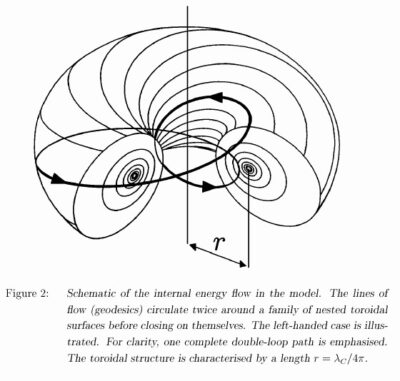 Toroidal electron image by John Williamson and Martin van der Mark
Toroidal electron image by John Williamson and Martin van der Mark
They actually wrote this paper in 1991, but struggled to get it published. In the end they had to settle for a rather obscure little journal called Annales de la Fondation Louis de Broglie. That’s the Louis de Broglie who had a letter on waves and quanta published in Nature in 1923. That’s where he said “the wave is tuned with the length of the closed path”. His 1924 thesis was on the theory of quanta. It was all about the wave nature of matter.
Vortex rings
Of course, by 1923 this sort of thing had been brewing for a hundred years. Check out the Wikipedia article on the toroidal ring model. It says it all began with André-Marie Ampère in 1823. It doesn’t mention Ampère’s molecular vortices, but it does say Lord Kelvin suggested in 1867 that vortex rings represented the only true atoms. This was before anybody knew about subatomic particles. The article goes on to tell us that shortly before 1900, JJ Thomson and Ernest Rutherford “sparked a revolution with experiments confirming the existence and properties of electrons, protons, and nuclei”. It also talks about the Bohr model. Helge Kragh gives an interesting rundown of that in his 2010 essay on The Early Reception of Bohr’s Atomic Theory (1913-1915). See page 15 for information about the magneton, which is nowadays usually called the Bohr magneton.
The Bohr–Procopiu magneton
It’s sometimes called the Bohr–Procopiu magneton. See the Wikipedia Timeline of quantum mechanics. It says in 1911 Ștefan Procopiu “performs experiments in which he determines the correct value of electron’s magnetic dipole moment, μB = 9.27×10ˉ²¹ erg·Gˉ¹ (in 1913 he is also able to calculate a theoretical value of the Bohr magneton based on Planck’s quantum theory)”. However as I speak I can’t find Procopiu’s 1911 paper Sur les éléments d’énergie or his 1913 paper Détermination du moment magnétique moléculaire par la théorie de M. Planck. I’ll get back to you on that. Meanwhile see the Wikipedia Bohr magneton talk page where Cristi Stoica has been sticking up for Procopiu.
Herbert Stanley Allen obtained the magnetic moment using the Bohr theory
Also see Spatial quantization and the discovery of the Bohr magneton by Timoji Ojkada dating from 2002. He says the concept that an atom’s magnetic moment is a multiple of a magneton was originally introduced by Pierre Weiss in 1911. And that “the assumption immediately forced itself on physicists that Weiss’ magneton was probably connected with the elementary quantum of action h”. He goes on to tell how Bohr mentioned Weiss’s magneton at the end of the third part of his 1913 trilogy. Note though that Bohr was talking about the orbital angular momentum of electrons, and not the spin angular momentum:
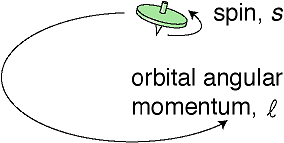
Spinning top image from Benjamin Crowell’s lectures on physics
Ojkada goes on to say tell us about Samuel Bruce McLaren, who “pointed out the connection between the magneton and Bohr’s assumption”. And how in 1914, according to McLaren’s suggestion, Herbert Stanley Allen “obtained the magnetic moment using the Bohr theory”. Allen’s letter to Nature was one of many under the heading Atomic Models and X-Ray Spectra. He said Professor John William Nicholson regarded Planck’s constant h as an angular momentum, and that according to Bohr’s theory, the angular momentum of an electron is constant and is h/2π. He also said this: “Suppose that an electron (charge e, mass m) is moving in a circular orbit (radius a) with angular velocity ω. Then its angular momentum is ma²ω, and the magnetic moment of the equivalent simple magnet is ½ea²ω. Thus the magnetic moment is equal to some constant multiplied by he/m. Taking (for illustration only) Bohr’s value for the angular momentum, we obtained as the magnetic moment 92 x 10ˉ²² EMU”.
The factor of two
The modern value of the Bohr magneton is 9.274 × 10ˉ²¹ erg·Gˉ¹ in CGS units. As Wikipedia says, the electron’s intrinsic spin magnetic moment, is approximately one Bohr magneton. It also corresponds to the magnetic moment of a 1s electron in hydrogen. Note this in the Wikipedia electron magnetic moment article: “the magnetic moment of an electron is approximately twice what it should be in classical mechanics. The factor of two implies that the electron appears to be twice as effective in producing a magnetic moment as the corresponding classical charged body”. Also note that there’s a double loop in the Williamson/van der Mark image. There’s also a double loop in this image of a trivial knot. Which is the first knot in Peter Guthrie Tate’s knot table.
The Parson magneton
The Wikipedia article on the toroidal ring model also refers to Alfred Locke Parson’s magneton. See Parson’s 1915 paper A Magneton Theory of the Structure of the Atom. He said “the essential assumption of this theory is that the electron is itself magnetic, having in addition to its negative charge the properties of a current circuit”. Spot on, Alfred. This was spot on too: “It may be pictured by supposing that the unit negative charge is distributed continuously around a ring which rotates on its axis (with a peripheral velocity of the order of that of light)”. On page 16 he said for the magnetic forces between magnetons to be great enough to account for chemical reactions, velocity “v must not be much less than c. It is simplest, therefore, to assume v to be equal to c”. Have a read of the Encyclopaedia Britannica article on displacement current, which plays “a central role in the propagation of electromagnetic radiation, such as light and radio waves, through empty space”.
The electron has a definite magnetic polarity which on account of gyroscopic action does not change rapidly in direction
The Wikipedia article on the toroidal ring model also says Parson’s theory attracted the attention of Arthur H Compton, who wrote a series of papers on the properties of the electron. One of these was the size and shape of the electron dating from 1919. You can find a non-paywalled copy on Sci-Hub. Compton proposed three alternatives, namely a rigid spherical shell of electricity, a flexible spherical shell of electricity; and a thin flexible ring of electricity. He concluded that “the diameter of the electron is comparable in magnitude with the wave-length of the shortest γ-rays”. There’s also Compton’s 1921 paper on the possible magnetic polarity of free electrons. Again you can find a non-paywalled copy on Sci-Hub. Compton talked about Charles T R Wilson’s cloud chamber pictures showing electrons moving in converging helices. He said this: “Mr. Shimizu accordingly suggested that Mr. Wilson’s photographs may be explicable on the assumption that the electron has a definite magnetic polarity which on account of gyroscopic action does not change rapidly in direction”.
The electron has a more nearly isotropic form
Last but not least there’s Compton’s 1921 paper the magnetic electron. Again see Sci-Hub for a non-paywalled copy. Again he referred to the Parson electron which featured a rotation with a “peripheral velocity of the order of that of light”. He also said this: “Whilst retaining Parson’s view of a magnetic electron of comparatively large size, we may suppose with Nicholson that instead of being a ring of electricity, the electron has a more nearly isotropic form”. On page 6 Compton says this: “The only adequate explanation of these experiments seems to be that interference occurs between the rays scattered from the different parts of the same electron. Such an explanation clearly implies that the diameter of the electron is comparable with the wave-length of the radiation employed, which means that the effective radius of the electron is of the order of 10ˉ¹⁰ cm”. He also gives C T R Wilson’s cloud chamber pictures:
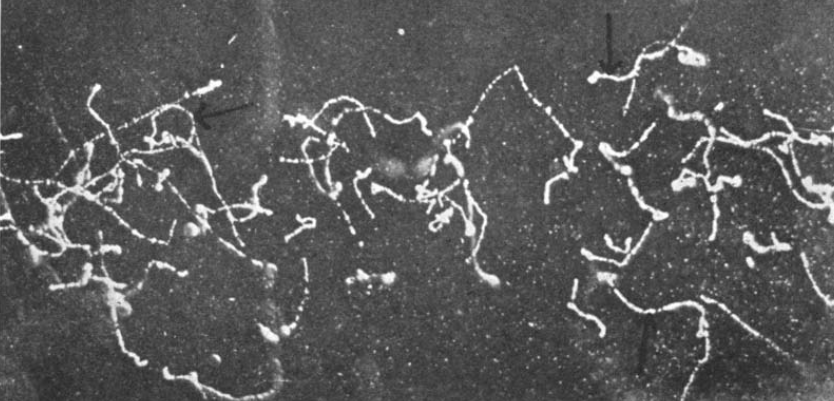 Image by C T R Wilson from Arthur Compton’s 1921 paper the magnetic electron
Image by C T R Wilson from Arthur Compton’s 1921 paper the magnetic electron
Here’s Compton nearly a hundred years ago, giving us the crystal clear evidence that the electron has an appreciable diameter and spins like a tiny gyroscope. With a “peripheral velocity of the order of that of light”.
Formed like an anchor ring
The Wikipedia toroidal ring model article also refers to Herbert Stanley Allen. He was still writing papers on the electron in 1921. See The Angular Momentum and Some Related Properties of the Ring Electron. Allen referred to Samuel Bruce McLaren, who was killed in the war in 1916. Allen said this: “Rejecting entirely the idea of magnetic or electric substance, he regarded the magneton as an inner limiting surface of the aether, formed like an anchor ring”. See McLaren’s very brief letter to Nature of 2013. Make a note of that inner limiting surface, because the eye of the storm is not the storm. Unfortunately Allen also talked about a very thin ring. Not a very fat ring. Unlike Compton, he didn’t share Nicholson’s view that “the electron has a more nearly isotropic form”. I should mention The Atomic Theory of John William Nicholson by Russell McCormmach dating from 1965. Sci-Hub is your friend. There’s no mention of displacement current.
Electron spin is real
I should also mention that Einstein did an experiment on all this stuff. With a little help from Wander Johannes de Haas, who was Hendrik Lorentz’s son-in-law. See a simple experiment to demonstrate Ampere’s molecular currents. When you surround a metal cylinder with a solenoid and turn on the current, the cylinder rotates. It’s something like the impulse that makes your garden hose reel rotate when you turn the water on – see page 11 of David Topper’s article on The Quirky Side of Scientists. It’s now known as the Einstein-de Haas effect, which “demonstrates that spin angular momentum is indeed of the same nature as the angular momentum of rotating bodies as conceived in classical mechanics”. It perhaps ought to be called the Richardson gyromagnetic effect, because it was predicted by Owen Willans Richardson in 1908. His paper was on a mechanical effect accompanying magnetization. He said “the moment of momentum acquired by the revolving electrons must thus be balanced by an equal reaction elsewhere”. And that “it would be made evident by a twisting of the suspended system as a whole”. The effect is the opposite of the Barnett effect. Samuel Barnett’s 1915 paper was on magnetization by rotation. When you rotate a body, you magnetize it. Barnett said “the cylinder will become magnetized in the direction in which it would be magnetized by an electric current flowing around it in a direction opposite to that of the angular velocity imparted to it”. The bottom line is that electron spin is real. There’s definitely something going round and round in there.
Knot Singularities in the Field
There’s other things I ought to mention of course. Like Gustav Mie’s 1913 foundations of a theory of matter. That’s where Mie said electrons “are not, as has been believed for twenty years, foreign particles in the ether, but they are only places at which the ether takes on a particular state”. Mie’s chapter 2 is Knot Singularities in the Field. How cool is that for 1913? Then of course there was the Stern-Gerlach experiment in 1922. It demonstrated that “particles possess an intrinsic angular momentum that is closely analogous to the angular momentum of a classically spinning object, but that takes only certain quantized values”. Then there was the 1926 discovery of electron spin by Samuel Goudsmit and George Uhlenbeck. Their paper on spinning electrons and the structure of spectra was published in Nature. Then came Llewellyn Thomas’s 1926 paper on the motion of the spinning electron. After that came Erwin Schrödinger’s 1926 paper quantization as a problem of proper values, part I. He said things like “a closer definition of the surface harmonic can be compared with the resolution of the azimuthal quantum number into an ‘equatorial’ and a ‘polar’ quantum’” and the “main difference is that de Broglie thinks of progressive waves, while we are led to stationary proper vibrations”. This was followed by quantization as a problem of proper values, part II. That’s where Schrödinger talked about wavefunction and phase and geometrical optics, and on page 18 said classical mechanics fails for very small dimensions of the path and for very great curvature.
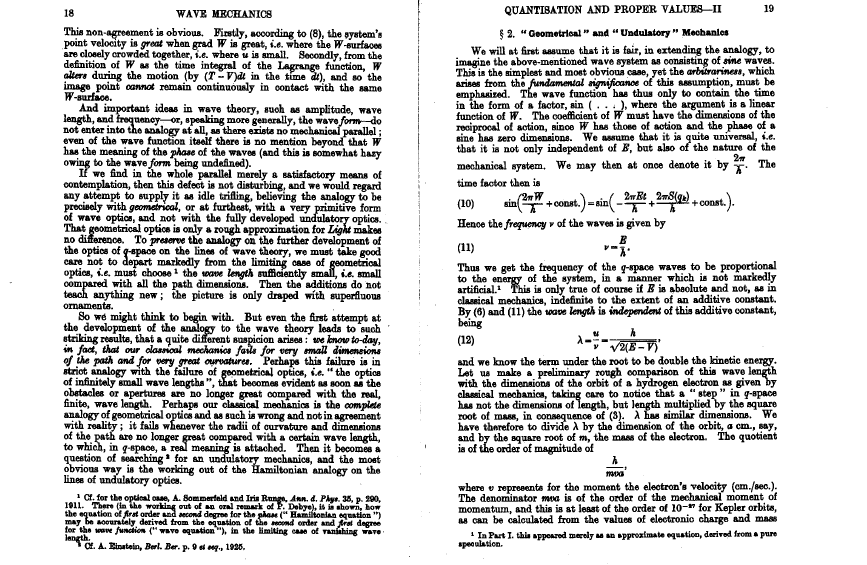
His quantization as a problem of proper values, part III continued on similar lines. He said “since then I have learned what is lacking from the from the most important publications of G E Uhlenbeck and S Goudsmit”. He referred to the angular moment of the electron which gives it a magnetic moment, and said “the introduction of the paradoxical yet happy conception of the spinning electron will be able to master the disquieting difficulties which have latterly begun to accumulate”. After that in December 1926 came Schrödinger’s Undulatory Theory of the Mechanics of Atoms and Molecules. This is where he said material points consist of, or are nothing but, wave-systems.
It possesses a quantity of a real motion
Then there was Franco Raseti and Enrico Fermi’s 1926 paper on the rotating electron. Special thanks to David Delphenich for the translation – his paper on the risk of premature unification is worth a read. Raseti and Fermi said “the electron has almost always been considered to be a material point up to now”. They also said this: “it was only in recent years that Uhlenbeck and Goudsmit made the hypothesis that the reason for some spectroscopic phenomena – in particular, the anomalous Zeeman effect – was to be found in a structural element of the electron. Those authors assumed precisely that the electron is animated with a rotational motion around itself, in such a way that it possesses a quantity of a real motion, namely, a magnetic moment”. Raseti and Fermi also said “despite the grave energetic difficulties that have been pointed out, one can conclude that the hypothesis of the rotating electron must not be abandoned”. Then came the 1927 Davisson-Germer experiment and the diffraction experiments by George Paget Thomson and Andrew Reid. These proved the wave nature of matter, which is why de Broglie got his Nobel prize. Then there was Charles Galton Darwin’s 1927 Nature paper on the electron as a vector wave, which talked about a spherical harmonic for the two directions of spin. Darwin also wrote a 1927 PRSA paper on the electron as a vector wave. He said we must regard the electron as a wave, and its motion in free space or weak fields can be treated by the ordinary theory of waves. He said “it is possible to regard the wave of the electron as in ordinary space”. Darwin’s 1928 papers included the wave equations of the electron, the magnetic moment of the electron, and on the diffraction of the magnetic electron.
The wave nature of the electron
So, that was the company de Broglie was keeping. That was his context. He was awarded the 1929 Nobel prize in physics “for his discovery of the wave nature of electrons”. Hence his Nobel lecture was entitled The Wave Nature of the Electron. He talked about a small trajectory which is closed or else turning back on itself. He also said “the phase of the associated wave must be a uniform function along this trajectory”. He finished up by saying this: “The electron can no longer be conceived as a single, small granule of electricity; it must be associated with a wave and this wave is no myth; its wavelength can be measured and its interferences predicted”. It all sounds cut and dried. Especially since Carl Anderson discovered the positron in August 1932, and Patrick Blackett and Giuseppe Occhialini discovered pair production in March 1933. Electron-positron annihilation to gamma photons was also discovered in 1933. Tim Dunker says it was discovered by Theodor Heiting rather than Frédéric Joliot and Jean Thibaud. But I’m not sure it matters. What matters is that you can make matter out of light:
 Strip images by me, GNUFDL spinor image by Slawkb, see Wikipedia
Strip images by me, GNUFDL spinor image by Slawkb, see Wikipedia
The minimum and maximum field variation combine, along with all points between, to form a standing wave that’s the same all round. There’s no discernible phase change, hence it looks like a standing field. And there is no outer edge to this field. The result is an electron. Or a positron. But the standing wave isn’t really standing. It goes round and round with a “peripheral velocity of the order of that of light”. It’s wrapped round twice in a double loop, hence it’s “a worble embracing itself”. Hence “the magnetic moment of an electron is approximately twice what it should be in classical mechanics“. Then when you annihilate it with the positron what you get is light. So let’s see now. What could be going round and round in there?
The inner angular momentum
Max Born and Leopold Infeld knew the answer. See their 1935 paper on the quantization of the new field theory II. On page 12 they said this: “the inner angular momentum plays evidently a similar role to the spin in the usual theory of the electron. But it has some great advantages: it is an integral of the motion and has a real physical meaning as a property of the electromagnetic field, whereas the spin is defined as an angular momentum of an extensionless point, a rather mystical assumption”. On page 17 they said this: “the rest-mass occurring in our theory is not, as in Dirac’s, an absolute constant of the system but the total internal energy, depending on rotation and internal motion of the parts of the system. An external field will influence not only the translational motion, but also these internal motions”. On page 23 they said this: “in the classical theory we got the result S = D x B = E x H”. They’re talking about the Poynting vector. The thing that’s going round and round is light. The current is displacement current. The electron is a “dynamical spinor”. Strictly speaking a spinor is a mathematical thing. William “Weylmann” Straub hates spinors. But like Wikipedia says: “in the 1920s physicists discovered that spinors are essential to describe the intrinsic angular momentum, or ‘spin’, of the electron and other subatomic particles”. You start with the anchor ring, then you inflate the torus through the horn torus stage all the way to the spindle-sphere torus. Then you’ve got a spherical symmetry that matches the S-orbital. Then “the electron has a more nearly isotropic form”:
Torus animations by Adrian Rossiter, S-orbital image from the 2010 Encyclopaedia Britannica
It all seems cut and dried, especially when you know about gravitomagnetism and frame dragging and optical vortices. And about the eye of the storm and the way counter-rotating vortices attract whilst co-rotating vortices repel.

But it isn’t cut and dried. Take a look at de Broglie’s 1934 book on the magnetic electron. Again special thanks to David Delphenich for the translation. Amazingly, incredibly, de Broglie talked about a wave of probability. He talked about Max Born’s probability amplitude for a point particle. He’d gone over to the dark side. He surrendered to the Copenhagen quacks who promoted Yakov Frenkel’s point-particle electron to spite Schrödinger. Despite all the evidence to the contrary. The Copenhagen quacks who peddled the lie that quantum mechanics surpasseth all human understanding. Quantum quacks like Dirac who referenced Charles Galton Darwin’s vector-wave electron in 1927, but in 1938 was still peddling point particles. Thank goodness the dark ages are nearly over. Because we now have people who refuse to shut up and calculate. We have people thinking for themselves. People like Williamson and van der Mark. People like Qiu-Hong Hu, who wrote a 2005 paper on The nature of the electron. Then there’s An Electron Model Consistent with Electron-Positron Pair Production from High Energy Photons by Donald Bowen and Robert V Mulkern. There’s Origins and demonstrations of electrons with orbital angular momentum by Benjamin J McMorran et al which talks about a quantum vortex model of matter. There’s A classical approach to the electron g-factor by Jaromir Chalupsky. There’s how electrons spin by Charles Sebens. There’s the Helical Solenoid Model of the Electron by Oliver Consa. There’s Hydrodynamics of Superfluid Quantum Space: de Broglie interpretation of the quantum mechanics by Valeriy Sbitnev:
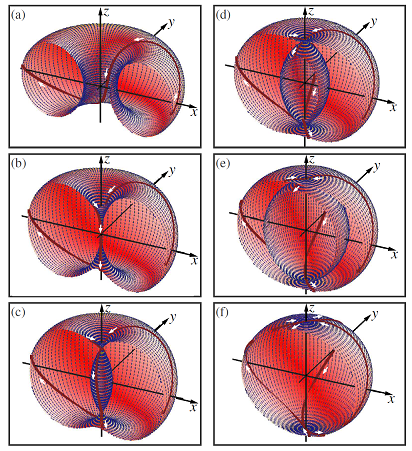 Ring torus transformations from Hydrodynamics of Superfluid Quantum Space: de Broglie interpretation of the quantum mechanics by Valeriy Sbitnev
Ring torus transformations from Hydrodynamics of Superfluid Quantum Space: de Broglie interpretation of the quantum mechanics by Valeriy Sbitnev
There’s more papers like this every day. They don’t all get it right, but they’re getting warm and barking up the right tree. It won’t be long before the ice melts and the new dawn comes. It won’t be long before the dark ages are over.
To understand the electron is to understand the world
Because it’s like Frank Wilczek said: “to understand the electron is to understand the world”. Of course, to understand the electron you also have to understand the photon, and how pair production works. Then you’d know that that renormalization was a kludge and that the Standard Model is a patchwork-quilt Frankenstein’s monster of a theory. It would also help if you knew about the polarizable vacuum approach to general relativity and how gravity works. And if you also knew what Bohm said in 1965 about matter being where the energy path is inward reflecting to-and-fro. Then you’d know that the mystery of mass is a myth. You’d also know that for a worble embracing itself, the embrace is strong. And that electron capture does what it says on the tin. And that the neutron’s charge disposition exactly matches the nuclear force. It would also help if you took in what Williamson and van der Mark said about space being curved and charge being topological. And about identifying a quark with a confined photon state which is not sufficient in itself to complete a closed loop. It “would then only be possible to build closed three-dimensional loops from these elements with qqq and q̄q combinations”. Why, if you knew all that, you’d have the beginnings of a theory of everything.
I know we’re thinking some of the same things when I’ve already got three quarters of the papers you mention in this article in my collection.
Something is coming, and I’m not sure the global village of professional academic theoreticians are going to like it.
Good stuff Tom. I share your sentiment. There may be trouble ahead!
Give those Copenhageners hell Boys ! Give ‘ em hell !
Thanks Greg.
.
All: I seem to be attracting some essay-writing spam at the moment. The comment is usually somewhat nonsensical, and the name is a hyperlink to some website where students can pay somebody to write their essays for them. Tsk. I shall delete such comments.
Looking forward to your next topic. I just came across your trefoil knot on page 6 and had to pass it along.
https://arxiv.org/pdf/1911.00499.pdf
fluid dynamics meets schrodinger
Neil
That looks interesting, thanks H. I shall read that with interest. Sorry I didn’t reply earlier. I was finishing off my next topic!
You will enjoy this!
https://www.youtube.com/watch?v=pnbJEg9r1o8
Steve: LOL, I enjoy watching Physics Girl! But best not mention that to the wife eh? As for Falaco solitons, I was playing with them in 2006. A Falaco soliton is like half a smoke ring. I mention them in https://physicsdetective.com/the-electron/ plus two other articles. IMHO an electron is akin to a smoke ring but with an additional “steering wheel” type rotation. Thomson and Tait played with smoke rings when they were doing the vortex atom. Jeez, were those guys ahead of their time.